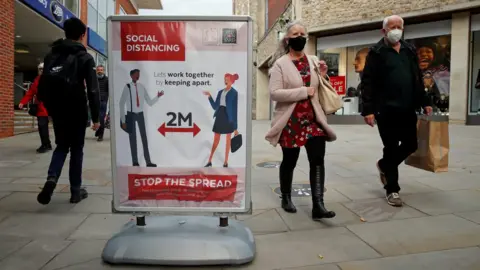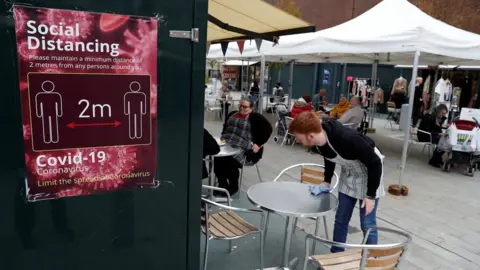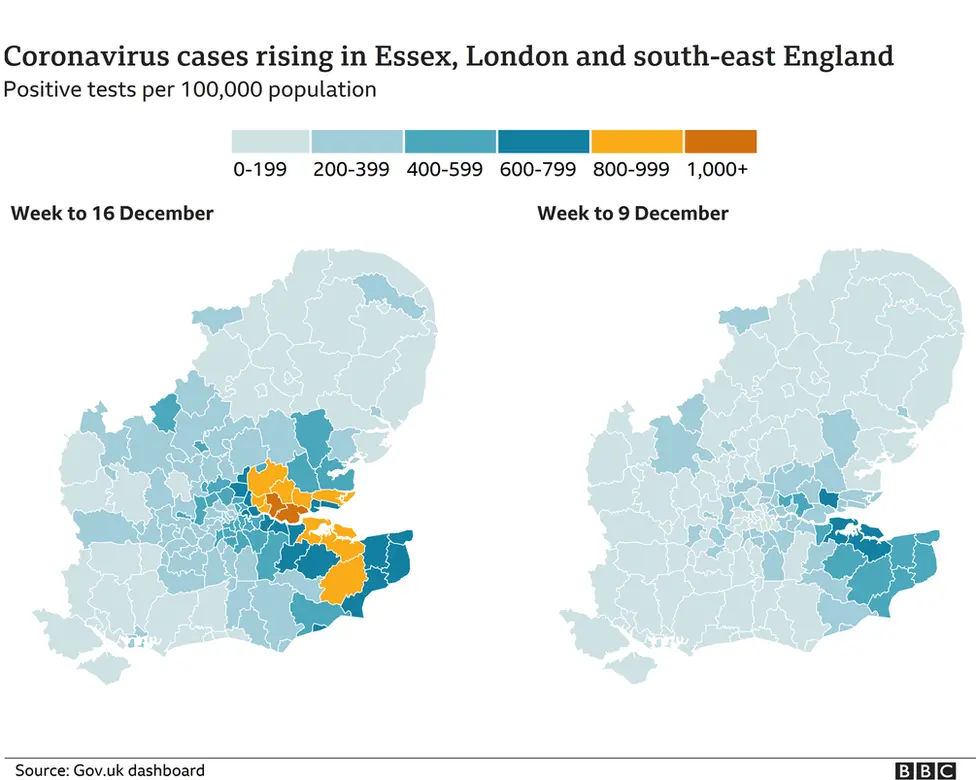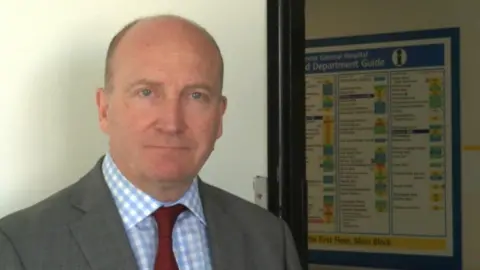Covid-19: Why are half of England's highest infection rates in Essex?
 Reuters
ReutersFive of the top 10 areas with the highest rate of Covid-19 infections are in Essex. Why, and what happens next?
The latest round of coronavirus figures make grim reading for the people of Essex.
Thurrock currently has the highest infection rate in England - with more than 1,000 cases per 100,000 people.
But it is the increase in the rate that for many will be most troubling, rising from 387.2 cases per 100,000 in the week up until 9 December to 1,056 last week.
 Reuters
ReutersBasildon has England's third highest rate with 995.2 cases per 100,000 people, followed by Epping Forest in fifth (956.8), Brentwood in seventh (875.1) and Rochford eighth (864.2).
The figures coincided with the government's decision to place all five areas of Essex - plus Braintree, Castle Point, Chelmsford, Harlow, Maldon and Southend-on-Sea - into the new tougher tier four restrictions.
Asked to comment on why Thurrock's rate was especially high, Thurrock Council did not offer any reasons.
Instead, it referred to a press statement issued over the weekend in which the council's leader Rob Gledhill said the rise in infections was "clear to see" and was putting "massive pressure on Basildon Hospital".
Essex County Council, which is not responsible for either Thurrock or Southend, said both the new variant of Covid-19 and increased testing has played a role in the increased infection rate in its area.
A spokeswoman said: "As is the case in other parts of the country, the new strain has contributed.
"Also the fact that we are testing people without symptoms - as well as those in the south of the county.
"South Essex has a large amount of testing capacity for asymptomatic people, which is obviously contributing to increasing case numbers."
 Chicken and Frog
Chicken and FrogFor Natasha Radford, who opened the Chicken and Frog book shop in Brentwood eight years ago, the rise in cases and the move to tier four could not have come at a worse time.
"That it was announced at 16:30 GMT on the last Saturday before Christmas blows my mind," she said.
"The timing could not have been worse.
"I actually agree with the lockdown from a health point of view but it should have happened three or four weeks ago. Instead, we've had this funny 'in between' lockdown and now this.
"We are taking orders online and over the phone but it's harder for us to guarantee the availability of what people want to buy. It is what it is."
 French Quarter
French QuarterMeanwhile, Linda Heath, who runs the independent gift shop French Quarter in Brentwood with her daughter Rebecca, said she was devastated by the tier four announcement.
She said the earlier announcement that three families could mix over Christmas had given people "a hope and expectation that things were improving" and told how she had ordered in "extra stock" as a result.
"Now, we're told [by the government] that actually we are going to shut you down for the busiest week of the year - the week that will see you through the next three months," she said.

Analysis: By Rob England, BBC England Data Unit

A month ago, Essex as a whole was seeing coronavirus infection rates of about 200 cases per 100,000 people - high for England, but it had major outliers on both sides.
Basildon, on the border with outer-London, had the highest rate of about 300 cases per 100,000, while areas like Tendring on the opposite side of the county had less than 100 per 100,000.
Now, Thurrock, the hardest-hit area, has a rate of more 1,000 cases per 100,000 people, with Basildon not far behind.
This is a grim milestone shared only by Nottingham, which passed it in early October, according to official figures.
Infection rates are increasing across the board, more than doubling in 10 out of 14 districts in Essex.
But there are still huge differences in where the virus is concentrated across the county, with Tendring still seeing a rate of about 200 per 100,000 in the week to 16 November.
This is similar to places seeing the highest infection rates in tier two - high alert.
But cases only tell part of the story.
The latest figures from NHS England suggest in mid-December the number of patients in hospital with coronavirus increased by 80% across trusts in Essex and neighbouring areas compared to late-November.
Since the pandemic began, more than 2,000 people from Essex have died having tested positive for coronavirus in the previous 28 days - 104 of those were in the last week.
It remains to be seen whether this surge in infections will affect the whole of the county, or just the areas which have been consistently hardest-hit over the last four months or so.

Health leaders in Essex now fear the rise in coronavirus infections will spread northwards.

Nick Hulme, chief executive of Ipswich and Colchester hospitals, said: "I think it is 15 cases we've seen of the new variant [of Covid-19] but we are keeping a very close eye on it.
"We also know that the pattern of the disease does tend to, in a sense, move up the A12 and we do see, certainly in south Essex, large numbers and, in Colchester, numbers are going up and in fact doubled over two days of inpatients just last week."
Giles Watling, Conservative MP for Clacton, which is currently in tier two, says the spike in cases were very concerning.
"People need to take this very seriously, and for people to take it seriously we need to get the message out loud and clear.
"At the moment our cases are relatively low, but from what I understand the march of this new mutation could break out here easily," he said.
"I am very concerned and people have to be very careful, stay in their bubbles and obey the rules."

- A SIMPLE GUIDE: How do I protect myself?
- AVOIDING CONTACT: The rules on self-isolation and exercise
- HOPE AND LOSS: Your coronavirus stories
- LOOK-UP TOOL: Check cases in your area
- STRESS: How to look after your mental health


Find BBC News: East of England on Facebook, Instagram and Twitter. If you have a story suggestion email [email protected]
